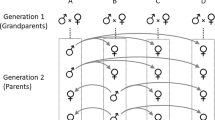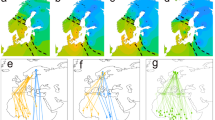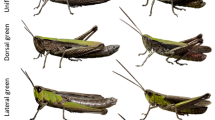Summary
Three natural populations ofTalitrus saltator living on differently orientated seashores and the offspring produced by crossing two of them were analysed by means of progeny tests, with the aim of gaining some data on the genetic control of solar direction finding. Data from fullsib family-analyses showed a genetic heterogeneity within at least two of the populations tested: some families oriented towards the sea, some in a different direction and others were dispersed. Intrafamily behaviour in the first and second generations and a mass analysis of dispersed families, suggests that dispersion may arise from segregation of heterozygous parental genotypes. The data obtained generally support the hypothesis of an oligogenic rather than a polygenic control of direction finding.
Similar content being viewed by others
Abbreviations
- TED :
-
theorical escape direction
- IED :
-
innate escape direction
References
Batschelet E (1981) Circular statistic in biology. Academic Press, London, pp xvi+371
Ehrman L, Parson PA (1981) Behavior genetics and evolution. Mc Graw-Hill Book Company, New York, pp xvi+450
Ginsburger-Vogel T (1973) Détermination génétique du sexe, monogénie et intersexualité chezOrchestia gammarella Pallas (Crustacé, Amphipode, Talitridae). Arch Zool Exp Gén 114:397–438
Pardi L (1960) Innate components in the solar orientation of littoral amphipods. Cold Spring Harbor Symp Quant Biol 25:395–401
Pardi L, Scapini F (1983) Inheritance of solar direction finding in sandhoppers: mass-crossing experiments. J Comp Physiol 151:435–440
Pardi L, Ercolini A, Marchionni V, Nicola C (1985) Ricerche sull'orientamento degli Anfipodi del litorale: il comportamento degli individui allevati in laboratorio sino dall' abbandono del marsupio. Atti Accad Sci Torino (I Cl Sci fis mat nat) 92:1–8
Scapini F (1985) Experiments on the innate directional tendency ofTalitrus saltator Montagu (Crustacea Amphipoda). Influence of age on the variability of solar orientation. Monitore Zool Ital (N.S.) 19
Scapini F, Pardi L (1979) Nuovi dati sulla tendenza direzionale innata nell'orientamento solare degli Anfipodi litorali. Atti Accad Naz Lincei Rc(Cl Sci fis mat nat) (Serie VIII) 66:592–597
Scapini F, Ugolini A, Pardi L (1985) Inheritance of solar direction finding in sandhoppers: II. Differences in arcuated coastlines. J Comp Physiol A 156:729–735
Ugolini A, Scapini F, Pardi L (1984) Solar orientation inTalitrus saltator Montagu (Crustacea, Amphipoda) from retrodunal lagoons. Monitore Zool Ital (N.S.) 18:181–182
Author information
Authors and Affiliations
Rights and permissions
About this article
Cite this article
Scapini, F., Buiatti, M. Inheritance of solar direction finding in sandhoppers. J. Comp. Physiol. 157, 433–440 (1985). https://doi.org/10.1007/BF00615143
Accepted:
Issue Date:
DOI: https://doi.org/10.1007/BF00615143




